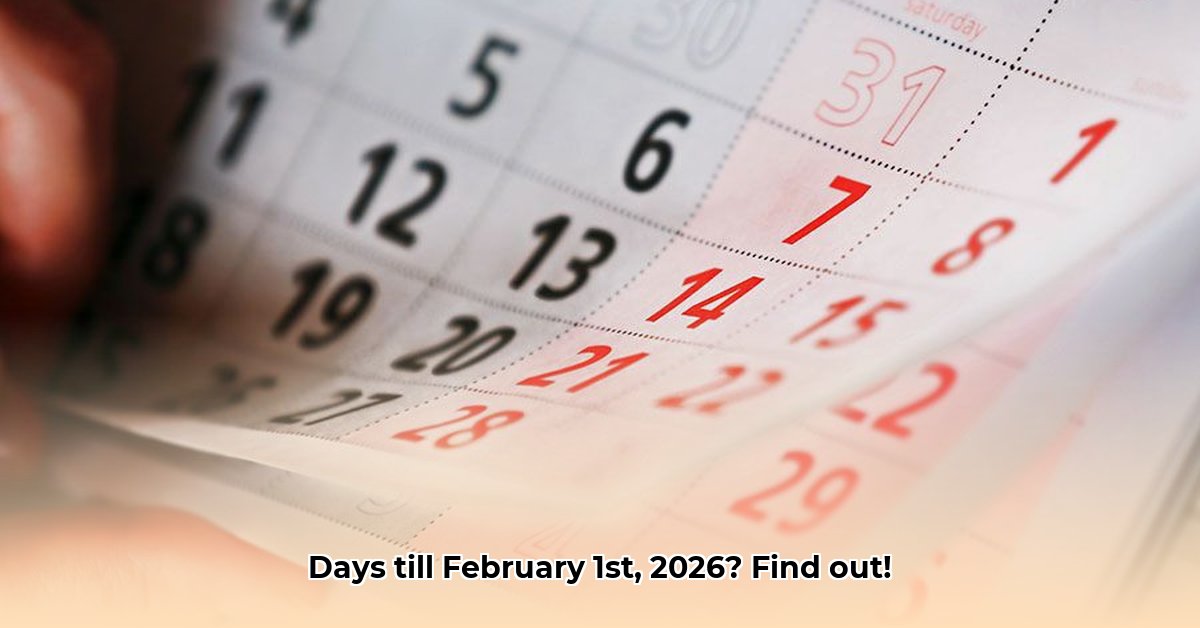Have you ever relied on an online date calculator, only to find conflicting information about the days left until a specific date? This article dives into the world of online date calculation, comparing several tools and their accuracy in determining the days between two dates. For more examples, check out this helpful resource on calculating days until a specific date: days until October 4. We’ll explore the reasons behind these discrepancies, including the impact of time zones and calculation methods. Finally, we offer tips and insights to ensure precise calculations for event planning, software development, and satisfying your curiosity about the passage of time.
Decoding the Countdown: How Many Days Until February 1st?
Determining the number of days remaining until February 1st, 2026, appears straightforward, yet online countdown calculators often present differing results. This article examines the reasons for these discrepancies, focusing on accurate date calculation methods and the importance of reliable time keeping. We’ll explore how seemingly minor variations can arise and why they matter.
The Countdown Conundrum: Unveiling the Discrepancies
Most online calculators estimate around 257 or 258 days until February 1st, 2026, from May 19th, 2025. These subtle differences stem from the diverse methodologies employed in date calculation, notably the specific time zone considered. For instance, some calculators operate using Pacific Standard Time (PST), directly influencing the end result. These variations can accumulate, much like measuring the same object with different measuring tapes. The choice of algorithm also plays a significant role. Some may account for leap seconds or other minor time adjustments, while others do not.
A Comparative Analysis: Evaluating Calculator Accuracy
Here’s a detailed comparison of various websites and their countdown calculations. Keep in mind that these figures are constantly updating:
| Website | Days Until Feb 1st, 2026 (approx.) | Time Zone Mentioned | Calculation Method | Last Updated |
|---|---|---|---|---|
| calendarr.com | 257 | No | Unspecified | May 19, 2025 |
| days.to | 258 | No | Unspecified | May 19, 2025 |
| howlonghowmany.com | 258 | America/Los_Angeles | Unspecified | May 19, 2025 |
| howlongagogo.com | 258 | No | Unspecified | May 19, 2025 |
| calculator.net | Calculation Tool | Yes | Gregorian Calendar Calculation | May 19, 2025 |
Note: All data accessed on May 19, 2025, and subject to change.
These minor discrepancies underscore the subtle variations inherent in different calculation approaches. Even the frequency with which a calculator updates its internal clock can influence the displayed result.
Real-World Implications: The Importance of Precision
While these discrepancies might appear insignificant, they hold considerable importance for specific applications:
- Website Developers: Accurate countdown timers are crucial for creating anticipation around product launches or events. They must precisely handle time zones, daylight saving time, and leap years to prevent user confusion and maintain credibility. Incorrect timers can damage brand reputation.
- Event Planners: Precise date calculations are paramount for orchestrating seamless events. Starting an event a day early or late due to inaccurate calculations can lead to logistical chaos and attendee disappointment. Reliable date tools and cross-verification are essential.
- Software Developers: When scheduling tasks, push notifications, or performing any date-sensitive function within their applications, developers require precise and consistent date calculations. Errors can result in missed deadlines, incorrect data processing, and a poor user experience.
- General Users: Understanding the potential variations in online tools prevents over-reliance on a single source for critical timing. Cross-referencing multiple calculators can provide a more reliable estimate, especially when planning significant events or deadlines.
The Bottom Line: Striving for Accuracy and Consistency
Calculating the days until February 1st, 2026, reveals the hidden complexities of seemingly straightforward date calculations. These subtle discrepancies emphasize the ongoing need for improved accuracy and consistency in digital tools. Developers and users alike benefit from awareness and careful selection of date calculation resources.
Precise Date Calculation: A Deep Dive into Time Zones and Methods
Accurately determining the days left until February 1st, 2026, requires more than a simple subtraction of dates. A thorough understanding of different calculation methods and the nuances of countdown accuracy considerations, including time zones and daylight saving, is essential. This knowledge is vital for a wide range of projects, from planning international events to developing time-sensitive software applications.
Beyond Simple Subtraction: The Critical Role of Time Zones
While basic date subtraction provides a general estimate, it falls short in real-world scenarios where time zones play a crucial role. The perceived number of days until February 1st, 2026, will differ for someone in New York compared to someone in London due to time zone differences. Simple subtraction ignores this critical factor, highlighting the need for accurate date calculation across time zones. Furthermore, daylight saving time (DST) adds another layer of complexity, as the offset between time zones changes during certain periods of the year.
A Comparative Evaluation of Date Calculators
Online calculators vary significantly in their handling of these complexities. Some provide only basic date difference calculations, while others incorporate sophisticated time zone management and daylight saving adjustments.
| Tool | Time Zone Handling | Daylight Savings Handling | Ease of Use | Accuracy | API Availability | Cost |
|---|---|---|---|---|---|---|
| Timeanddate.com Date Duration Calculator | Excellent | Excellent | Excellent | Excellent | No | Free |
| WolframAlpha | Excellent | Excellent | Good | Excellent | Yes | Paid option |
| Calculator.net | Calculation | Calculation | Calculation | Calculation | Calculation | Calculation |
| Google Calendar | Excellent | Excellent | Excellent | Excellent | Yes | Free/Paid |
(Note: This table reflects capabilities as of May 19, 2025. Features and pricing may change. Thorough testing is always recommended for any critical application.)
A Step-by-Step Guide: Mastering Accurate Date Calculation
To accurately determine the days until February 1st, 2026, from your specific location:
- Select a Reputable Online Date Calculator: Choose a tool known for its accurate handling of time zones and daylight saving time. Timeanddate.com and WolframAlpha are reliable options.
- Specify Your Location: Input your city or time zone to ensure the calculations are based on your local time.
- Enter the Target Date: Input February 1st, 2026, as the target date.
- Review and Verify the Results: Carefully examine the results, paying attention to the displayed time zone and any disclaimers regarding accuracy. Cross-reference the results with another reputable calculator for verification.
By following these steps and choosing reliable countdown tools, you can significantly improve the accuracy of your date calculations.
A Cross-Platform Comparison: Achieving Countdown Accuracy to February 1st, 2026
Are you seeking the most accurate countdown to February 1st, 2026? This exploration reveals the subtle yet significant differences in calculations across various online platforms. We’ll examine the factors that contribute to these variations and provide guidance on selecting the best tool for your needs.
The Countdown Conundrum: Investigating Time Zone Nuances
A close examination of popular online countdown tools reveals that, while most tools agree on the overall date, minor discrepancies in seconds and minutes often emerge. These discrepancies likely stem from a combination of factors, including:
- Server Time Synchronization: The accuracy of a countdown timer depends on the precision of its server’s internal clock. Variations in server time synchronization can lead to slight timing differences.
- Time Zone Handling: While many sites allow users to specify their time zone, the accuracy and reliability of this feature vary. Some sites may not fully account for daylight saving time transitions or may use outdated time zone databases.
- Underlying Calculation Algorithms: The algorithms used to calculate the time remaining until a target date can also contribute to discrepancies. Some algorithms may be more precise than others, taking into account leap seconds or other minor time adjustments.
It’s akin to measuring with different rulers; slight variations are inevitable.
Essential Considerations: Time Zone Standards and API Integration
Time zone handling is often overlooked but is a critical factor affecting the accuracy of countdown timers. While many sites allow you to specify your time zone, the accuracy and reliability vary significantly. Consistent countdowns across different time zones are essential for global events and applications. The lack of widespread API standardization hinders seamless integration between countdown timers and other applications. This limits the ability of developers to create custom solutions that rely on precise countdown data.
Peeking Behind the Curtain: How Accurate Timers Work
Online countdown timers calculate the time until February 1st, 2026, by using their server time and sophisticated algorithms. Most provide a user-friendly interface and free access. However, their calculations
















